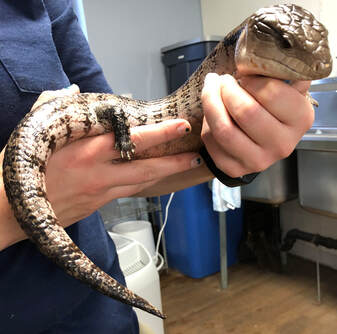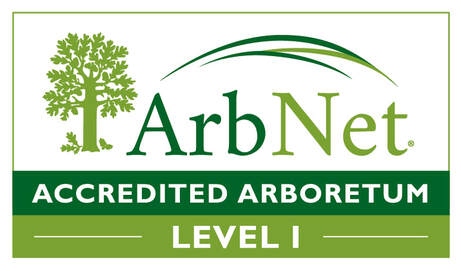Blue-tongued Skink (Tiliqua scincoides)

Physical Description: The Blue-tongued Skink has a sturdy body with an unusually large head. Adults are 1.5 to 2 feet long with short legs. They weigh on average about one pound.
Blue-tongued Skinks have smooth overlapping scales that form distinct color patterns going from light brown streaks to various tones of brown and silvery grey. The hefty tail of the Blue-tongued Skink is marked with dark cross bands. They are named for their most prominent feature, which is a large, flat, and notched tongue, that is a vivid blue inside a bright pink mouth.
Blue-tongued Skinks have transparent eyelids to block out sun or keep out dirt, however their lower eyelid moves up unlike humans who have an upper eye lid that moves down. They are ectotherms and rely on external sources of heat, like the sun, to regulate their body temperature.
Habitat: Blue-tongued Skinks prefer open grasslands with ample sunlight in the midst of leaf litter, rocks and wood logs.
Range: They live in eastern and central Australia, away from the continent’s interior.
Diet: They are omnivores. They eat small plants, arthropods, snails, and worms.
Lifespan: They live 15-18 years in the wild and average 20 in human care.
Social Structure: Blue-Tongued Skinks will live alone outside of the breeding season. They are fiercely territorial and will attack any other Blue-tongued Skink that enters its territory. The mother will birth 15-25 young at a time who will stay with the mother only until their first shed. They will then live alone and reach maturity at 3 years of age.
Status: Least Concern1
Other: Like all reptiles, Blue-tongued Skinks rely on the sense of smell by flicking their tongue to collect biochemical particles from the air to detect subtle changes in the environment. The flicking of the tongue can occur as many as 300 times per hour.
1 https://www.iucnredlist.org/species/109481538/109481555
Blue-tongued Skinks have smooth overlapping scales that form distinct color patterns going from light brown streaks to various tones of brown and silvery grey. The hefty tail of the Blue-tongued Skink is marked with dark cross bands. They are named for their most prominent feature, which is a large, flat, and notched tongue, that is a vivid blue inside a bright pink mouth.
Blue-tongued Skinks have transparent eyelids to block out sun or keep out dirt, however their lower eyelid moves up unlike humans who have an upper eye lid that moves down. They are ectotherms and rely on external sources of heat, like the sun, to regulate their body temperature.
Habitat: Blue-tongued Skinks prefer open grasslands with ample sunlight in the midst of leaf litter, rocks and wood logs.
Range: They live in eastern and central Australia, away from the continent’s interior.
Diet: They are omnivores. They eat small plants, arthropods, snails, and worms.
Lifespan: They live 15-18 years in the wild and average 20 in human care.
Social Structure: Blue-Tongued Skinks will live alone outside of the breeding season. They are fiercely territorial and will attack any other Blue-tongued Skink that enters its territory. The mother will birth 15-25 young at a time who will stay with the mother only until their first shed. They will then live alone and reach maturity at 3 years of age.
Status: Least Concern1
Other: Like all reptiles, Blue-tongued Skinks rely on the sense of smell by flicking their tongue to collect biochemical particles from the air to detect subtle changes in the environment. The flicking of the tongue can occur as many as 300 times per hour.
1 https://www.iucnredlist.org/species/109481538/109481555






